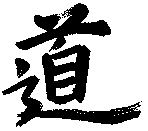 |
Taoism And The Taoist Arts |
||||||||||||
Main Concepts |
|||||||||||||
Background & History: The Taoist Arts: |
Yin And YangThe yin/yang symbol is one of the oldest and best known symbols in the world, but few understand its meaning. It represents the two poles of existence which are opposite but complementary, and which exist in everything. Yin represents everything that is feminine, dark, withdrawn, receptive and passive and things moving down and in. Yang represents the masculine, bright, forceful and expansive, and movement out and up. According to the philosophy, everything contains both yin and yang - this is why we see a spot of white in the black segment of the yin/yang symbol and vice versa. In fact, as something reaches an extreme it always becomes its opposite. This is illustrated in nature in many ways, but applies to all things: a storm is preceded and followed by a great stillness; cold replaces hot replaces cold in the constant cycle of the seasons; an organisation that is too strict will cause a rebellion when the rules become too tight; a balloon will burst if overinflated. These examples seem trivial, but a person who can spot yin and yang operating in the world can predict the outcome of events. It also accounts for the Taoist's sense of contentment - he has accepted that things change and evolve constantly, moving first one way and then the other. Thus he does not feel upset or worried when obstacles or hard times come - he knows that things will improve. Nor does he get caught up with riches or power when they come his way. Though he might enjoy them, he knows that they are not permanent, and willingly waves them good-bye when the time is right. In the internal arts the cultivation of the inner power (chi) can be seen as the yang, while the development of softness represents the yin. Movements in the T'ai Chi forms are constantly expanding then contracting, and practitioners are taught not to put themselves in extreme positions to avoid being caught off balance. The interplay of these forces forms the basis of Taoist philosophy,
and much has been written about them in the Taoist classics.
The Five Elements (Wu Hsing)The 5 elements theory has the same underlying philosophy as the Yin/Yang theory - that of constant change and evolution. The elements, or 'winds', are earth, metal, fire, wood and water are best understood as phases of a constantly moving cycle. Each grows and replaces the next in much the same way as the seasons progress. Each of the elements can be seen as the manifestation of a particular aspect of Chi, and they also correspond to colours, tastes, seasons, directions and parts of the body, among other things. Many different cycles can be identified within the 5 elements, but the 2 most common are the Shen (Constructive) and Ko (Controlling or Desctructive):
When the correspondences are considered, these cycles become more practical. For example, in traditional Chinese medicine, a person may complain of trouble with the lungs and weeping or grief, and as these are classified as metal characteristics earthy herbs with a metal boosting nature may be employed and foods classified as fire would be restricted, as fire destroys or hinders metal. In this way the balance of energy in the body will be regained. As you can imagine, a full an detailed understanding of yin and yang and the five elements as required by disciplines such as Traditional Chinese Medicine is extremely involved and requires much study. However, the important point is the underlying philosophy - that everything changes, and furthermore, changes in accordance to a universal law, and that appreciating the changes and working with them not against them makes for a peaceful and happy life.
Main Concepts pt 2 >>
|
||||||||||||
|
|
|||||||||||||